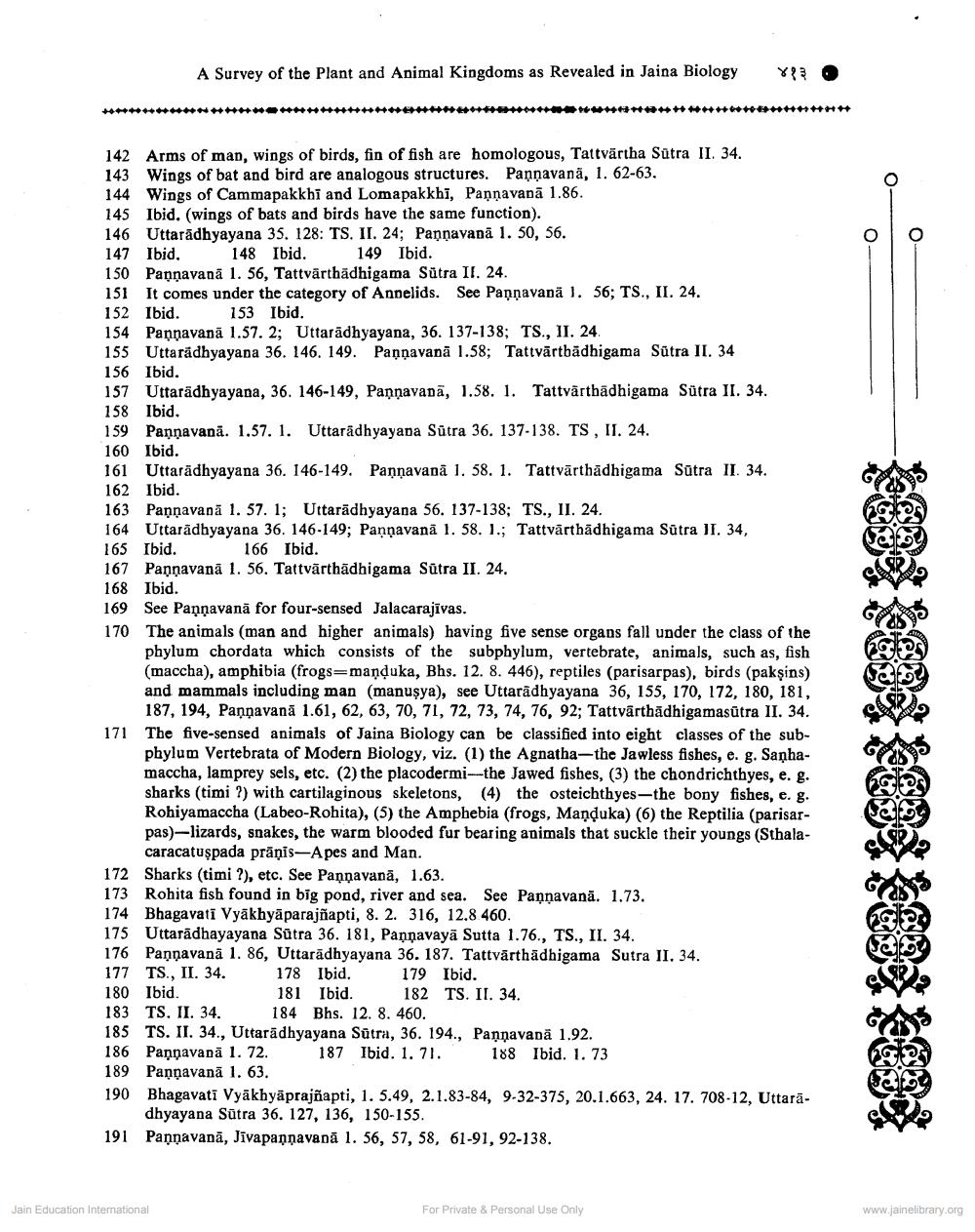________________
A Survey of the Plant and Animal Kingdoms as Revealed in Jaina Biology
142 Arms of man, wings of birds, fin of fish are homologous, Tattvärtha Sūtra II. 34. 143 Wings of bat and bird are analogous structures. Panṇavana, 1. 62-63. 144 Wings of Cammapakkhi and Lomapakkhi, Paņṇavanā 1.86.
145 Ibid. (wings of bats and birds have the same function).
146 Uttaradhyayana 35. 128: TS. II. 24; Pannavana 1. 50, 56. 147 Ibid. 148 Ibid. 149 Ibid.
150 Pannavana 1. 56, Tattvärthādhigama Sütra II. 24.
151 It comes under the category of Annelids. See Panṇavana 1. 56; TS., II. 24. 152 Ibid.
153 Ibid.
60++++++++
154 Pannavana 1.57. 2; Uttaradhyayana, 36. 137-138; TS., II. 24.
155 Uttaradhyayana 36. 146. 149. Pannavana 1.58; Tattvartbädhigama Sutra II. 34 156 Ibid.
157 Uttaradhyayana, 36. 146-149, Pannavana, 1.58. 1. Tattvärthadhigama Sutra II. 34. 158 Ibid.
159 Pannavana. 1.57. 1. Uttaradhyayana Sutra 36. 137-138. TS, II. 24.
160 Ibid.
161 Uttaradhyayana 36. 146-149. Pannavana 1. 58. 1. Tattvärthadhigama Sūtra II. 34. 162 Ibid.
163 Pannavanā 1. 57. 1; Uttaradhyayana 56. 137-138; TS., II. 24.
164 Uttaradhyayana 36. 146-149; Panṇavana 1. 58. 1.; Tattvarthādhigama Sūtra II. 34, 165 Ibid. 166 Ibid.
167 Pannavanā 1. 56. Tattvärthādhigama Sutra II. 24.
168 Ibid.
169 See Pannavana for four-sensed Jalacarajīvas.
170 The animals (man and higher animals) having five sense organs fall under the class of the phylum chordata which consists of the subphylum, vertebrate, animals, such as, fish (maccha), amphibia (frogs=maṇḍuka, Bhs. 12. 8. 446), reptiles (parisarpas), birds (paksins) and mammals including man (manuşya), see Uttaradhyayana 36, 155, 170, 172, 180, 181, 187, 194, Panṇavanā 1.61, 62, 63, 70, 71, 72, 73, 74, 76, 92; Tattvärthadhigamasutra II. 34. 171 The five-sensed animals of Jaina Biology can be classified into eight classes of the subphylum Vertebrata of Modern Biology, viz. (1) the Agnatha-the Jawless fishes, e. g. Sanhamaccha, lamprey sels, etc. (2) the placodermi-the Jawed fishes, (3) the chondrichthyes, e. g. sharks (timi ?) with cartilaginous skeletons, (4) the osteichthyes-the bony fishes, e. g. Rohiyamaccha (Labeo-Rohita), (5) the Amphebia (frogs, Manduka) (6) the Reptilia (parisarpas)-lizards, snakes, the warm blooded fur bearing animals that suckle their youngs (Sthalacaracatuṣpada prāņis-Apes and Man.
172 Sharks (timi ?), etc. See Panṇavanā, 1.63.
173 Rohita fish found in big pond, river and sea. See Pannavanā. 1.73.
174 Bhagavati Vyakhyāparajñapti, 8. 2. 316, 12.8 460.
175 Uttaradhayayana Sutra 36. 181, Pannavaya Sutta 1.76., TS., II. 34.
176 Pannavana 1. 86, Uttaradhyayana 36. 187. Tattvarthädhigama Sutra II. 34.
177 TS., II. 34.
178 Ibid.
179 Ibid. 182
180 Ibid.
181 Ibid.
184 Bhs. 12. 8. 460.
183 TS. II. 34. 185 TS. II. 34., Uttaradhyayana Sutra, 36. 194.,
186 Pannavanā 1. 72.
187 Ibid. 1. 71.
189 Panṇavanā 1. 63.
Jain Education International
TS. II. 34.
Pannavanā 1.92.
188 Ibid. 1. 73
४१३
190 Bhagavati Vyakhyāprajñapti, 1. 5.49, 2.1.83-84, 9-32-375, 20.1.663, 24. 17. 708-12, Uttaradhyayana Sūtra 36. 127, 136, 150-155.
191 Pannavana, Jīvapaņņavana 1. 56, 57, 58, 61-91, 92-138.
For Private & Personal Use Only
www.jainelibrary.org




